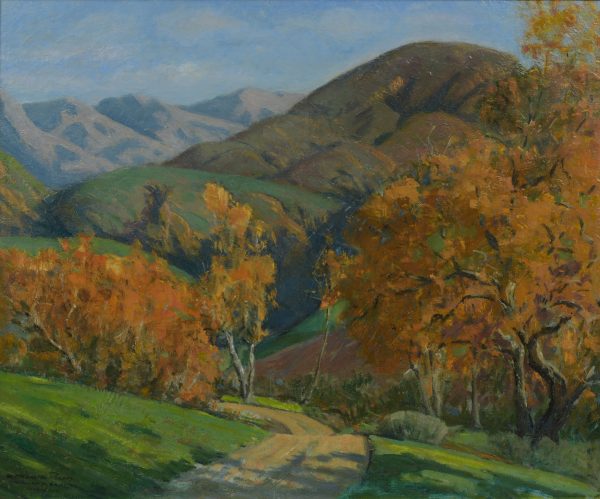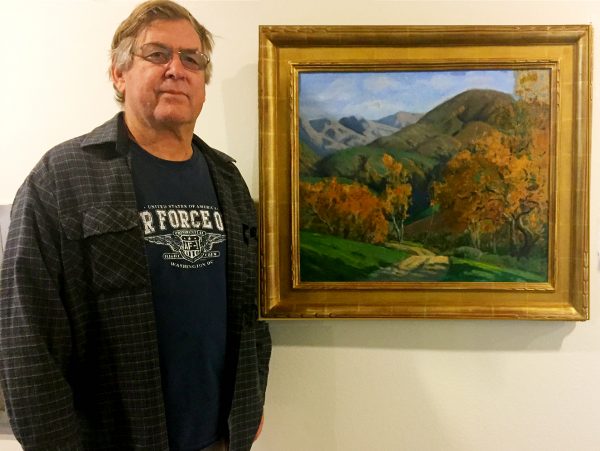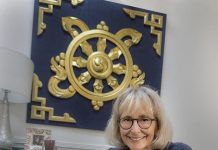
It’s a charming view of Aliso Canyon, with a verdant green foreground and the brownish ochre hills of Aliso Canyon dominating the background. Brushstrokes are flat and fairly undramatic and the palette true to the earthy canyon colors of the Laguna Beach area. It’s titled “Untitled. Aliso Canyon.”
Out of the public eye since 1933 when William Griffith painted it and then gave it to his friend Allan Barnes Goff, it is currently on view for the first time at City Hall as part of an exhibition of works from the Festival of Arts’ permanent collection.
The painting had been in the family for three generations, most recently ensconced in the Costa Mesa living room of Goff grandson Gary, where it was more or less taken for granted as a relic of the past. Time and atmospheric elements meanwhile had taken their toll.
Recognizing its historical value nonetheless and motivated by his friendship with Pat Sparkuhl, who curates the permanent collection, Goff donated it to the Festival of Arts in Oct. 17, 2015, according to Festival documents. Sparkuhl had it restored to its former glory by Susan Brown of SBConservation, based in Laguna Beach.
“I grew up with that painting and eventually it came to me,” said Goff, whose early relatives were among the town’s homesteaders. “If I wanted to keep the painting in the family, I would have restored it, but I thought it would be more important to the history of Laguna.”
The historic connection includes his aunt, Doris Goff, having embodied a Madonna in an early Pageant of the Masters.
“The painting has once again become the treasure it was intended to be,” said Sparkul. With a handmade frame, it looks as if the artist just delivered it, he said.
Lacking the grandeur of the art colony’s other plein air luminaries Edgar Payne or William Wendt, Giffith’s work nonetheless represents parts of Laguna Beach’s artistic and social history. One wonders why it lacks better illumination in its first public showing.
Griffith (1866-1940) came to Laguna Beach around the same time as Wendt, Payne, Frank Cuprien and Anna Hills. In 1918 these artists and others held their first art exhibition and, spurred on by its success, founded the Laguna Art Association. Co-incidentally, both Griffith and Hills, at separate times, studied at the Académie Julian in Paris. Hills also served as the association’s first vice-president and second president after Payne. Griffith served as president of the art association from 1920 to ’21 and from 1925 and ’27.
He moved to Laguna Beach from Kansas where he was well-known as a portrait and figurative painter. Once here, he fell in love with landscape/plein-air painting while not entirely abandoning figurative representation as his iconic work “Bathers at Diver’s Cove,” attests.

Laguna Beach was not only an artists’ enclave, but home to early settlers such as the Goff clan, the Thurstons and the Heislers, all who made a strong imprint on the town’s foundation. For example, Myrtle Goff was active in civic affairs, Allan was the town plumber and Henry Goff, a builder, established the second hotel in Laguna Beach in 1889. The present Hotel Laguna stands on the same site. There’s also a Goff Cove and the somewhat unprepossessing Goff Street, off Park Avenue.
Gary’s great-grandparents, Leon and Nettie Barnes Goff, were among the earliest Orange County homesteaders, receiving a land tract in the 1890s.
His grandfather, Allan Barnes Goff, born on Aug. 6, 1882, married Myrtle Mae Martin in 1908. She was the daughter of a building contractor, who built Laguna’s first movie theater. The couple lived for decades in the mobile home park that preceded development of the Montage resort. They had five children including Gary’s father Jack Goff, who moved his family to Costa Mesa in 1953 to lessen the commute to his job at Douglas Aircraft, in Long Beach, said Gary Goff.
While “Aliso Creek” is emblematic of early Laguna Beach, the City Hall exhibition also features other distinguished works from FoA’s permanent collection with historical cachet, such as Virginia Woolley’s 1930 painting “Brunch.”
Wooley arrived in Laguna Beach in 1923 and became one of the FoA founders. She remained active in the festival until 1971.
Altogether, Sparkuhl has created a small exhibition that nonetheless sheds light on FoA’s history and aesthetic bent of its artists and jurors.
The show runs through Jan. 20 and can be seen at 505 Forest Ave., Monday through Thursday, 7:30 a.m. to 5:30 p.m. and 7:30 a.m. to 4:30 p.m. on alternate Fridays.





[…] felt left out of Secret Santa when I read the Indy article, “Newly Restored Painting Reveals Early Laguna.” The grandson of an early Laguna homesteader, Allan Barnes Goff, donated a landscape painting […]